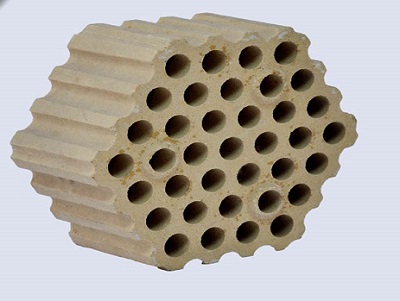Brief introduction and characteristics of silica brick
May 27, 2022
What is silica brick?
The siliceous refractory brick is a refractory product with a content of more than 93%. It uses quartzite as the material, participates in a few mineralizers, and is fired at high temperatures. Its mineral composition is a complex structure of tridymite, cristobalite, a few residual quartzes, and vitreous composed of high temperature. Silica brick is a dry acid refractory material, which has strong corrosion resistance to acid slag, but is severely corroded by alkaline slag, and is easily damaged by oxides containing A1203, K20, Na20, etc., and has excellent resistance to oxides such as Ca0, Fe0, Fe203 resistance.
The mineral phase composition of silica brick is mainly tridymite and cristobalite, and a few quartzes and vitreous. Tridymite, cristobalite, and residual quartz have a large change in volume due to the change of crystal form at low temperature, so the thermal stability of silica brick at low temperature is very poor. During use, it should be slowly heated and cooled below 800°C to avoid cracks. Therefore, it is not suitable to be used in kilns with dramatic temperature changes below 800 °C.

What are the characteristics of silica brick?
(1) High thermal conductivity. Coke is smelted from coking coal by conduction heating by the wall of the combustion chamber in the carbonization chamber, so the silica bricks used to build the walls of the combustion chamber should have high thermal conductivity.
In the temperature range of the coke oven prison, silica bricks have higher conductivity than clay bricks and high alumina bricks. Compared with the general coke oven silica brick, the performance rate of dense coke oven silica brick can be improved by 10%~20%;
(3) Excellent thermal shock resistance at high temperatures. Periodic coal charging and coking out of the dry coke oven cause the temperature of the silica bricks on both sides of the combustion chamber wall to change drastically. Under the unstable temperature range of normal operation, it will not cause severe cracks and spalling of the silica brick. Because the coke oven silica brick has excellent thermal shock resistance above 600 °C;
(4) High-temperature volume is stable. In the silica brick with excellent crystal transformation, the residual quartz is not more than 1%, and the expansion during heating is concentrated at 600C, and then the expansion obviously slows down. During the normal operation of the coke oven, the temperature does not drop below 600 °C, the masonry is not changed greatly, and the stability and tightness of the masonry can be maintained for a long time.
The higher deformation temperature under load is the excellent conductivity of silica brick. The melting point (1670°C, 1713°C) near tridymite and cristobalite is not firm between 1640-1680°C. When the silica brick is calcined again, it remains in the brick. The continuous transformation of quartz will cause irreversible volume expansion. The volume of silica bricks is stable in the range above 300°C and close to the melting point (tridymite or cristobalite). When heated to 1450°C, about 1.5%-2.2% of the total volume expands. It is tightly sealed to ensure that the masonry has excellent airtightness and structural strength. The disadvantage of silica brick is low thermal shock stability (about 1-4 times of heat exchange in water), followed by low refractoriness (generally 1690-1730 ℃), which greatly restricts its application design. Silica bricks are mainly used in coke ovens, glass melting furnaces, acid steelmaking furnaces, and other thermal equipment.
Relevant information
-

Main properties of magnesium oxide refractory
Performance characteristics of magnesia refractories and other basic refractories Performance characteristics of magnesia refractories and other basic refractories Refractories containing more than 80% ... -

What properties of lightweight insulation fire clay bricks can be improved by the addition of kyanite?
Lightweight insulation fire clay bricks are a kind of shaped refractory material with clay as the main raw material, which is processed, shaped, dried, and calcined with clay. on the kiln. Due to the r ... -

How is the effect of white fused alumina abrasive used in refractory materials?
After mixing, forming, drying, and firing at high temperature in a shuttle kiln. The product has the characteristics of high refractoriness, good thermal shock stability of white corundum, high high te ... -

Characteristics of refractory magnesia chrome bricks for lime kiln
Lime kilns are mainly classified into square kilns and circular kilns. According to the classification of fired products, they can be divided into lime kilns, ceramic kilns, cement kilns, glass kilns, ...

